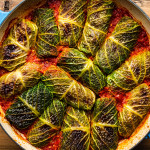Baked vegan cabbage rolls (gołąbki)
5.0
(6)
Your folders
Your folders
Prep Time: 40 minutes
Cook Time: 50 minutes
Servings: 14
Author : Ania

Ingredients
Export 20 ingredients for grocery delivery
Instructions
Step 1
Soak porcini mushrooms in 400 ml / scant 1¾ cups of boiling water to soften them and to obtain a mushroom infused stock. I recommend 8 hours at least, 24 hours is even better. If making your own tomato sauce, get it going first (recipe below) and then return to the rolls while it simmers.
Step 2
Chop fresh mushrooms into a small dice. If using a food processor, slice thickly first and use the pulse method. Pulse mushrooms in smaller batches and be very careful not to overprocess, you want coarse dice, not mush.
Step 3
Heat up oil in a large pan you have a lid for. Add diced shallots, fry them off on a low-medium heat until soft and translucent (about 10 minutes). Next add in garlic - fry for a few minutes stirring frequently as it burns easily.
Step 4
Stir in smoked paprika, a good pinch of salt and pepper and thyme leaves. Stir all the ingredients around for a few seconds on low heat, next add half of the chopped mushrooms. If the water released from the mushrooms does not deglaze the pan, add a splash of wine.
Step 5
Once the first portion of the mushrooms cooks down a little, add the second. Allow it to cook down completely, before adding the rest of the wine, finely chopped porcini (make sure you rinse the grit off first and keep the stock), walnuts, balsamic and soy sauce. Carry on cooking the mushroom mixture until all the excess liquid evaporates. Taste and adjust the seasoning being mindful that rice will dilute the intensity.
Step 6
Next, add in rinsed rice and all of the mushroom stock without the grit that tends to settle at the bottom. Cover the pot and bring the mixture to a gentle simmer, once it starts to simmer count about 10 minutes, then switch off the heat and keep the lid on the pan for a further 5 minutes. Taste and adjust the seasoning if needed.
Step 7
Remove the leaves of the cabbage by making a delicate incision at the bottom of each leaf (where it attaches to the head), prising the leaf off gently. You will need about 14 whole leaves in total. I used large and medium leaves from 2 cabbage heads and kept the rest for a stir-fry or soup.
Step 8
Bring a big pot of water to the boil and grab a large bowl, fill it with cold water (ice cubes help but are not necessary).
Step 9
Plunge 4-5 leaves at a time into the boiling water. Blanch them, submerged fully (a smaller lid is often used to weigh them down), for 3-4 minutes. Fish them out and plunge them into the cold water.
Step 10
Thin the outside stem of each leaf with a sharp knife (see photos). Run the knife along the stem trimming off any excess that jets out above the leaf's surface.
Step 11
Set the oven to 200° C / 390° F and grab a large oven proof dish / saucepan, ideally with a fitting lid but you can also use a piece of kitchen foil.
Step 12
Pour 480 ml / 2 cups of tomato sauce and 240 ml / 1 cup of water to the bottom of the dish. Mix the two together.
Step 13
Place a trimmed cabbage leaf on the work bench so that the inside faces you. Place a tablespoon or two (depending on the size of the leaf) of the filling at the bottom of each leaf, fold the sides to the middle and then roll the leaf gently until the filling is safely enclosed inside. Place it snugly in the prepared baking dish, with the seam down. Continue with the remaining leaves in the same manner.
Step 14
Cover the pot with a lid and bake for about 20 minutes.
Step 15
Remove the lid and bake for a further 20 minutes, until the sauce has thickened and the cabbage leaves are fully cooked through (a sharp knife should slide right through the thickest part of the leaf). If you want the cabbage leaves charred, switch the oven to the grill function for the last 10 minutes (or so) and brush the leaves lightly with olive oil - watch carefully as they can burn quickly.
Step 16
Heat up oil in a pan, once hot add diced onion and fry off on a low-medium heat until soft and translucent (about 10 minutes). Next add in garlic - fry for a few minutes stirring frequently as it burns easily.
Step 17
Add canned tomatoes. If using plum tomatoes, add one can at a time, squashing the whole tomatoes with a wooden spoon. Add tomato paste, a good pinch of salt, pepper and chilli (if using), plus a can's worth (about 500 ml / 2 cups) of water to the pan. Stir everything well and allow it to simmer gently for about 20 minutes.
Step 18
Give everything a good stir every 20 minutes (I find that the sauce take about 60 minutes of simmering time) and squash down any stubborn tomato pieces you see. As soon as the pan is starting to look dry but the tomatoes are still quite chunky, add more water (I add about 1 litre / 4 cups in total).
Step 19
Once the sauce is thick, more or less uniform (i.e all the tomatoes have broken down nicely), taste and adjust the seasoning, including adding a small amount of sugar if you find it too acidic.